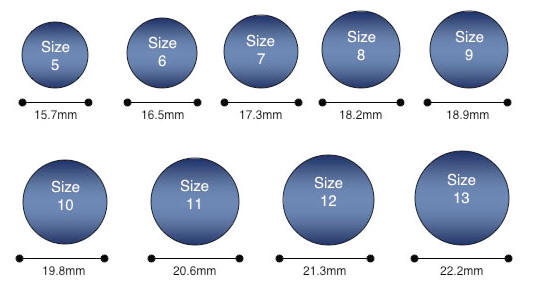No products in the cart.
Jewelry Guide – Jewelry Size Guide
The Jewelry Size Guide describes the various ring sizes and necklace lengths. These size guides should be useful for you and will help you to get the best fitted rings and necklaces.
- Ring Size Guide
- Necklace Length Guide
Ring Size Guide
A ring should fit comfortably on the finger of the wearer as well as be snug enough to prevent it from accidentally falling off. The best and most accurate way to measure a ring size is by visiting a local jeweler. Jewelers use a set of graduated rings and other specialized tools to determine ring size. Ring size can also be measured easily at home by any of the following ways:
Ring Size Measurement by Ring’s Diameter
The diameter of a ring can be determined by measuring the distance across the middle inside. You can use the ring size circles below (based on ring’s diameter) for measuring your exact ring size. Please follow the steps listed below to get an accurate ring size:
- Select a ring that fits comfortably on the finger for which you want to know the size.
- Take a printout of the visual ring chart below as per the print instructions below.
- Place your ring over the circles to match up with the nearest circle size to find the inside size of the ring.
- If the ring falls in between two sizes, then it is advisable to go for the larger size.
Ring Size Measurement by Ring’s Circumference
The circumference of a ring is measured by the length around the inner circle. You can use the finger size strip below for measuring your exact ring size. Please follow the steps to get the accurate ring size:
- Take a printout of the below as per the given print instructions.
- Carefully cut this printout from the image outline to get a size strip. Also cut a slit inside the strip at the left end.
- Wrap this size strip around the finger you wish to measure with the scale facing out and then slide the narrow end of the strip through the slit.
- Pull the narrow end until the fit is snug. Try to move that fit through the largest part of the finger; this may be the knuckle.
- The number that lines up at the slit represents the ring size for that finger.
Print Instructions
To get accurate ring size results, please follow these print instructions:
- You must make sure that you do not have ‘Shrink oversized pages to fit paper size’ or ‘Expand small pages to paper size’ selected in the Print Dialog Box.
- You must also make sure that you have taken printouts without changing the image size either intentionally or unintentionally.
- You can verify the sizes of the image printouts by measuring them with a ruler.

Tips for Measuring Accurate Ring Size
- You should avoid measuring cold fingers as this is when fingers are at their smallest size.
- You should measure your finger in warm temperatures at the end of the day.
- If your ring size falls in between two ring sizes then it is advisable to go for the larger size.
Tips if you’re buying the Ring as a Surprise
- You should try to find out from a reliable source; friend, parent, etc. what the intended recipient’s ring/finger size is.
- You can also borrow your intended recipient’s best fitted ring and find out the ring size by using above mentioned diameter method.
Other Tips and Information
- Engagement and wedding rings are traditionally worn on the ring finger on the left hand. The ring finger is located between the little finger and the middle finger.
- Ring sizes are expressed differently in different countries. All sizes listed in the above images and in tips are standard American Sizes.
- The average adult woman’s ring size ranges between sizes 5 to 7 whereas the average adult man’s ring size ranges between sizes 9 to 11.
Conversion Chart for Ring Sizes
The following chart will be useful in conversion of measured ring size in inches or in millimeters to numbered size applicable in USA and Canada. This chart also shows ring sizes applicable in UK, Ireland, Australia, Japan and Switzerland.
Facts about International Ring Sizing
- In the United States and Canada, ring sizes are specified using a numerical scale, with quarter and half sizes.
- In the United Kingdom, Ireland and Australia, ring sizes are specified using an alphabetical scale, with half sizes.
- In Japan, ring sizes are specified using a numerical scale, with only whole sizes.
- In Switzerland, ring sizes are specified using a numerical scale, with quarter and half sizes.
- In Europe (excluding Ireland and the UK), ring sizes are specified using a numerical scale, with half sizes.
Resizing your Ring
Most gold or silver rings can be resized by a skilled jeweler by way of soldering or stretching and compressing. However, some rings cannot be resized due to gemstone setting, plating, shape or surface design. Usually small resizing does not create problems, but more extreme resizing can noticeably impact the look and structure of your ring. Increasing the size of a ring typically requires gentle hammering and this will cause the shank of the ring to thin slightly. For decreasing or increasing the ring size, your jeweler may also remove or insert extra metal through soldering. Some jewelers do not resize platinum because of its density and strength.
